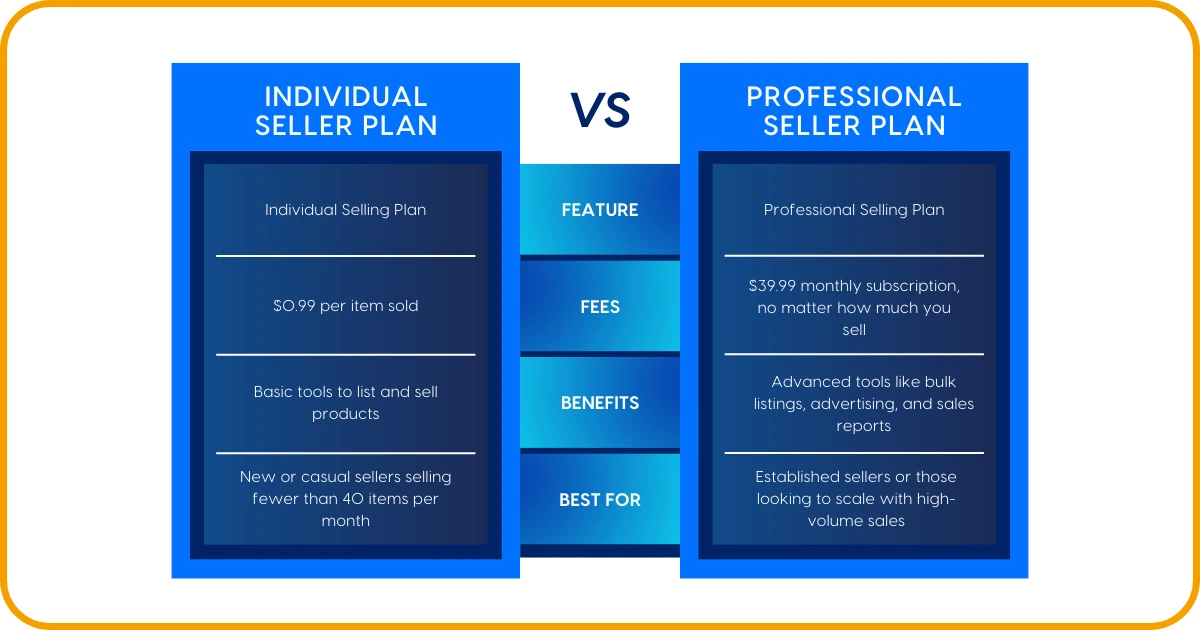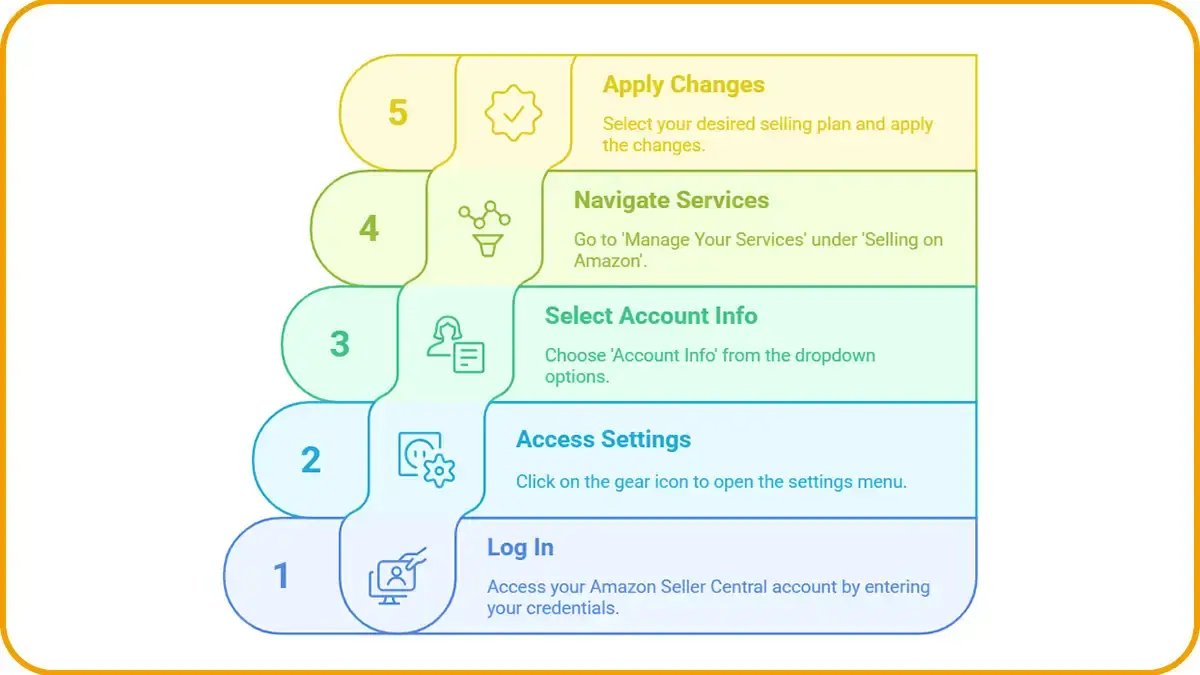Thinking about selling on Amazon but not sure which plan is right for you? Should you start small, or are you ready to grow and maximize your sales? If you’ve been wondering which plan will give you the best value, you’re in the right place.
Amazon offers two selling plans: Individual and Professional. Each plan has different benefits, and choosing the right one can make a big difference in your success. So, let’s break it down in a simple way to help you decide!
Understanding Amazon Seller Plans
The key difference between the individual and professional accounts lies in their fees and available features.
Individual Seller Plan
The individual plan is suited for sellers who sell fewer than 40 items per month and prefer to avoid a monthly subscription fee. However, they are charged a fee of $0.99 for each item sold. If you’re just getting started and don’t expect to sell more than 40 items per month, the Individual plan is a good option.
- Cost: $0.99 per item sold (plus additional fees)
- Best For: Sellers with fewer than 40 sales per month
- Features: Basic listing tools, limited access to reports
- Ideal User: Hobbyists, casual sellers, or those testing Amazon’s platform

Professional Seller Plan
The professional plan, on the other hand, is designed for sellers who expect to sell more than 40 items per month. This plan requires a monthly subscription fee of $39.99 but eliminates the per-item fee. Additionally, professional sellers benefit from advanced features such as bulk listing, advertising tools, and eligibility for top placement on product detail pages. If you plan to sell more than 40 items a month, the professional plan is a better choice.
- Cost: $39.99 per month (flat fee) plus additional selling fees
- Best For: Sellers exceeding 40 sales per month
- Features: Bulk listing, advertising tools, sales analytics, eligibility for Buy Box placement
- Ideal User: Growing businesses, brands, and high-volume sellers
Let’s Break this Down with an Example
Imagine two sellers, both passionate about handcrafted products but operating at different scales. One is a small handicraft seller who creates unique pieces in limited quantities, selling about 50 items per month. The other is a mid-sized handicraft seller with a steady customer base, managing to sell around 100 items monthly.
The small seller chooses the Individual Plan because it seems like the easier option—no monthly commitment, just a simple per-item fee. Meanwhile, the mid-sized seller, expecting consistent sales, opts for the Professional Plan.
Let’s do the math.
| Seller Type | Plan Type | No. of Items Sold | Cost per Item | Monthly Subscription | Total Cost |
|---|---|---|---|---|---|
| Small Handicraft Seller | Individual Plan | 50 | $0.99 per item | No subscription fee | $49.50 |
| Mid-Sized Handicraft Seller | Professional Plan | 100 | No per-item fee | $39.99 per month | $39.99 |
Now, here’s the real question: which seller is making the smarter financial decision? At first glance, the Individual Plan seems like a great deal—no commitments, no upfront costs. But as sales grow, so do the fees. The small seller, despite selling half as many products, is actually paying more than the mid-sized seller, simply because of how their plan is structured. Wouldn’t it make more sense to switch to the Professional Plan once sales cross 40 items per month?
So, if you’re a seller, where do you stand? Are you just starting out, testing the waters with a few sales here and there? Or are you seeing a steady demand for your products? If you’re selling more than 40 items a month, why pay more when you could be keeping more of your profits?
Why Choose a Professional Seller Account
Still unsure about upgrading to a Professional plan? Here are some big advantages that might help you decide:
- Win the Buy Box: Ever seen the “Add to Cart” or “Buy Now” button on a product page? That’s the Buy Box, and about 82% of Amazon sales happen through it! Professional sellers are eligible to compete for it, which can boost your sales.
- Sell in Gated (Restricted) Categories: Some product categories on Amazon require approval to sell in. Professional sellers can apply to sell in these gated categories, which can open up more opportunities.
- Bulk Listing: If you’re managing a large inventory, manually listing items can be a nightmare. With the Professional plan, you can upload products in bulk and make life easier.
- Use Third-Party Software: A Professional plan lets you connect with tools that help you track inventory, manage bookkeeping, and simplify orders, saving you time and reducing mistakes. If you’re managing a large inventory, manually listing items can be a nightmare. With the Professional plan, you can upload products in bulk and even integrate third-party inventory management tools to make life easier.
- Advertise and Promote Your Products: Want your products to appear on the first page of search results and boost sales? Professional sellers get access to Sponsored Product Ads, which put your products in front of the right customers. This is a huge advantage over Individual sellers.
Comparison Table: Individual Seller Plan Vs Professional Seller Plan
| Feature | Individual Plan | Professional Plan |
|---|---|---|
| Subscription Fee | $0.99 per item sold | $39.99 per month |
| Listing Products | One at a time | Bulk listing tools |
| Inventory Management | Individual entries | Bulk management |
| Order Fulfillment | Manual processing | Advanced options |
| Pricing Tools | Static pricing only | Dynamic pricing |
| Access to Reports | Basic reports | Detailed analytics |
| Promotions and Advertising | Not available | Available |
| Eligibility for Buy Box | Not eligible | Eligible |
| Additional Users | Single user | Multiple user access |
| Branding Tools | Not available | Enhanced brand tools |
| API Integration | Not available | Available |
| Restricted Categories Access | Not eligible | Eligible to apply |
| Fulfillment by Amazon (FBA) Access | Available | Available |
| Amazon Marketplace Web Service (MWS) | Not available | Available |
By understanding these distinctions, you can select the plan that best aligns with your business goals and operational needs.

The Professional plan offers advanced features suitable for businesses aiming to scale, while the Individual plan is tailored for casual or low-volume sellers.
Factors to Consider When Choosing a Plan
Before making a decision, ask yourself these questions:
- How many products do I plan to sell each month?
If it’s under 40, stick with the Individual plan. If it’s more, go Professional. - What’s my budget for fees?
Individual sellers pay per sale, while Professional sellers pay a fixed monthly fee. - Do I need advanced tools?
If you want bulk listing, detailed reports, or advertising options, the Professional plan is better. - Am I planning to grow my business?
If you’re thinking about scaling up, a Professional account will help you manage the growth. - Do I need marketing tools?
Advertising and brand management tools are only available with the Professional plan.
For example, if you sell handmade crafts occasionally, the Individual plan might be perfect. But if you’re selling electronics or trending products, the Professional plan will give you more tools to compete.
How to Switch Between Selling Plans
Good news! You can switch between Individual and Professional plans anytime. Here’s how:

Steps to Switch Plans
- Log in to Amazon Seller Central
- Click on the gear icon in the top-right corner
- Select Account Info from the dropdown menu
- Navigate to Manage Your Services > Selling on Amazon
- Choose Professional or Individual, then click Apply Changes
Important Notes When Switching
- Upgrading to Professional: Your subscription starts immediately, and you get access to all advanced tools right away.
- Downgrading to Individual: If you use services that require a Professional plan, you’ll need to cancel them first.
Tips for a Smooth Transition
Switching plans is easy, but here are some tips to avoid issues:
- Review Your Business Goals: Before switching, check if the new plan fits your needs.
- Check Your Enrollments: Some services, like advertising and bulk listing, won’t be available if you downgrade.
- Plan Around Your Billing Cycle: Switching at the right time can help avoid extra charges.
- Monitor Your Sales: Keep an eye on your sales after switching to make sure everything runs smoothly.
- Ask for Help: If you have any questions, Amazon Seller Support is always available.
Final Thoughts: Which Plan Should You Choose
Both plans have their benefits—it all depends on what works best for you. If you’re just starting out and testing the waters, the Individual selling plan is a simple and cost-effective way to begin. But if you are serious about your business and want to scale up, the Professional plan offers powerful tools to help you succeed.
So, are you ready to start selling on Amazon? Pick the plan that fits your business today, and remember—you can always upgrade when you’re ready to take things to the next level! Start small, see how it goes, and upgrade depending on your business needs.
Frequently Asked Questions
Simply register on Amazon under the Individual selling plan. If you plan to sell more than 40 items a month, you can switch to the Professional plan later.
No, your listings will stay the same. But if you switch to an Individual plan, some features like advertising and promotions won’t be available.
Yes, you can switch as often as needed. Just keep in mind that changes take effect immediately and may impact your billing.
No, there are no additional fees to switch. However, the fee structure changes depending on the plan you choose.
No, both Individual and Professional sellers can use FBA, but Professional sellers get lower fulfillment fees.
No, only Professional sellers have access to Amazon’s promotional and advertising tools.
You will retain access to Professional features until the end of your billing cycle, but you won’t be charged for the next cycle.
No, Amazon allows you to switch plans at any time without any long-term commitment or cancellation fees.
The Professional plan provides access to detailed reports and performance metrics. However, the Individual plan has limited tracking and analytics features.







